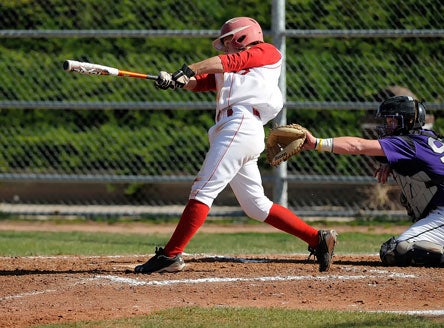Most state coaches and players are liking the change to new bats, saying it has improved play overall.

Batters like Regis Jesuit's Max George have noticed the changes bat regulations have brought along. Home runs are more difficult to hit - but still attainable for good hitters.
Photo by Tim Visser
Although you wouldn't be able to tell by looking at their statistics, even
Tyler Tucker and
Evan Walter know things are different this spring.
Colorado's, and the country's, change to a safer, less-potent aluminum bat for varsity baseball was forecast to drastically reduce home runs, and, more importantly, be safer.
Roughly two months into the change, the transformation has seemed to produce more praise than whining. Home runs are down across the board, but the players who hit them anyway, such as
Faith Christian (Arvada) star Tucker and
Thomas Jefferson (Denver) slugger Walter, are continuing to do so.
Tucker has a state-leading nine and Walter a Class 4A-best eight.
"The bats are the same with the pop and everything, but I just think they've made the sweet zone smaller," said Tucker, a left-handed first baseman and pitcher. "You definitely have to have the right swing and right mechanics now to get one out."
Largely gone are the days when a 137-pound, ninth-place hitter can coax a cheap home run by getting barrel on the ball. Now, when a guy crushes one, it's well deserved.
"It comes down to perfecting the swing," Walter said. "With the sweet spot being smaller, it puts more emphasis on how you prepare for the at-bat. For power hitters it's not that much of a difference, but it kind of feels more like a wood bat."
The change is the same one college baseball implemented last season. Without boring you with a technology lesson, the new bats must meet the BBCOR standard (bat-ball coefficient of restitution). In layman terms, the trampoline effect has been eliminated, creating more reaction time for fielders.
A study by the Southeastern Conference last season showed the bats were having a pronounced effect, with homers down about 40 percent, runs down from 8.06 to 6.68 per game and pitchers' ERA down from 4.04 to 3.17.

Small-ball is making a comeback forteams like Valor Christian thanks to thenew bat regulations.
Photo by Paul DiSalvo
Similar results throughout the NCAA had high school players and coaches wondering if their game was going to suddenly transform into soccer.
"Surprisingly, they're not as bad as we thought they were going to be,"
Monarch (Louisville) catcher
Fred Good said. "We've had a few home runs this year, but it definitely makes you hit it on the sweet spot to get it out."
Many coaches have given the move a thumbs-up because it allows them to, well, coach.
"The new bats have really changed things for the better in my opinion," longtime
Pomona (Arvada) skipper E.J. Mapps said. "Less home runs, but I haven't seen a huge decline in runs among the teams who still hit well. It's just more doubles and sac flies. I like the premium it has placed on now being able to bunt and run the bases correctly and hit in situations to move and score runners."
Few realized it at the time, but when Cherry Creek's Ian Wilson homered in the final inning of a state-championship loss to Regis Jesuit last season, it marked the final time Colorado fans would here the distinctive "ping" of the old bats that signified a home run.
Perhaps the state record of 19 home runs by Standley Lake's Drew Jackson a dozen years ago is now further cemented, but if someone does beat it, it will be well earned.
"With the old bats, there were a lot of no-doubters," Walter said. "With the new ones, you pretty much have to tattoo it to know it's gone."
The flip side is the benefits to pitchers. In addition to not having to worry as much about heat-seeking rockets back to the mound, pitching to contact is no longer as hazardous to one's ERA.
"It's crazy when you're pitching to notice the difference of how far the ball travels and how fast it comes off the bat," Tucker said.
Added Mapps: "Now pitchers don't have to nibble. They can come straight at hitters and challenge them by getting ahead, throwing strikes and letting their defense make plays behind them. They don't have to worry about every strike they throw getting hit 400 feet."
The change will distinctly slice Colorado baseball into two eras, the before and after, just as it has done for college baseball. Similarly (but without the scandal), it figures to have an effect more prominent than Major League Baseball's power reduction after performance-enhancing drugs were banned.
So far, change has been good.
"I like the change, to be honest," Tucker said. "It separates the great power hitters from the mediocre power hitters who just relied on the bat."